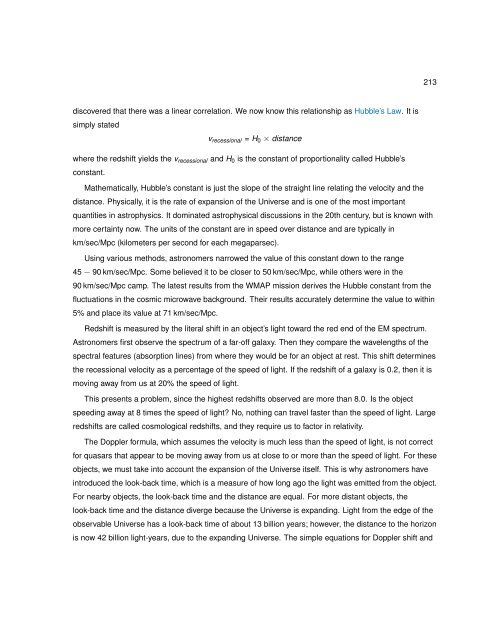Digital Universe Guide - Hayden Planetarium
Digital Universe Guide - Hayden Planetarium
Digital Universe Guide - Hayden Planetarium
Create successful ePaper yourself
Turn your PDF publications into a flip-book with our unique Google optimized e-Paper software.
discovered that there was a linear correlation. We now know this relationship as Hubble’s Law. It is<br />
simply stated<br />
vrecessional = H0 × distance<br />
where the redshift yields the vrecessional and H0 is the constant of proportionality called Hubble’s<br />
constant.<br />
Mathematically, Hubble’s constant is just the slope of the straight line relating the velocity and the<br />
distance. Physically, it is the rate of expansion of the <strong>Universe</strong> and is one of the most important<br />
quantities in astrophysics. It dominated astrophysical discussions in the 20th century, but is known with<br />
more certainty now. The units of the constant are in speed over distance and are typically in<br />
km/sec/Mpc (kilometers per second for each megaparsec).<br />
Using various methods, astronomers narrowed the value of this constant down to the range<br />
45 − 90 km/sec/Mpc. Some believed it to be closer to 50 km/sec/Mpc, while others were in the<br />
90 km/sec/Mpc camp. The latest results from the WMAP mission derives the Hubble constant from the<br />
fluctuations in the cosmic microwave background. Their results accurately determine the value to within<br />
5% and place its value at 71 km/sec/Mpc.<br />
Redshift is measured by the literal shift in an object’s light toward the red end of the EM spectrum.<br />
Astronomers first observe the spectrum of a far-off galaxy. Then they compare the wavelengths of the<br />
spectral features (absorption lines) from where they would be for an object at rest. This shift determines<br />
the recessional velocity as a percentage of the speed of light. If the redshift of a galaxy is 0.2, then it is<br />
moving away from us at 20% the speed of light.<br />
This presents a problem, since the highest redshifts observed are more than 8.0. Is the object<br />
speeding away at 8 times the speed of light? No, nothing can travel faster than the speed of light. Large<br />
redshifts are called cosmological redshifts, and they require us to factor in relativity.<br />
The Doppler formula, which assumes the velocity is much less than the speed of light, is not correct<br />
for quasars that appear to be moving away from us at close to or more than the speed of light. For these<br />
objects, we must take into account the expansion of the <strong>Universe</strong> itself. This is why astronomers have<br />
introduced the look-back time, which is a measure of how long ago the light was emitted from the object.<br />
For nearby objects, the look-back time and the distance are equal. For more distant objects, the<br />
look-back time and the distance diverge because the <strong>Universe</strong> is expanding. Light from the edge of the<br />
observable <strong>Universe</strong> has a look-back time of about 13 billion years; however, the distance to the horizon<br />
is now 42 billion light-years, due to the expanding <strong>Universe</strong>. The simple equations for Doppler shift and<br />
213





